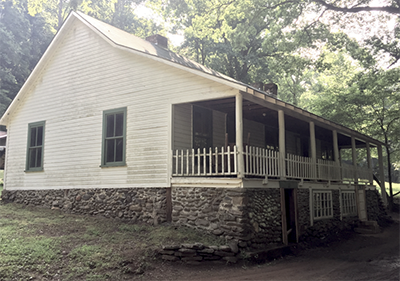
A lot can be said about hiking the easy grade of Hazel Creek, so named for the abundance of hazel trees that line its banks. But first you have to get there. Hiking Hazel Creek Trail requires equal parts planning, execution and trust. Planning is easy. You and your fellow hikers just need to agree on a date and time to commence your adventure. With that minor detail settled, execution begins when you catch the boat shuttle for the 30-minute ride across the western edge of Lake Fontana.
The trust portion of this particular trip was divided into three parts. First, we had to trust we’d have a ride home as we stood on the lake’s north shore and watched the boat motor away. Second, we needed to trust our ability to explore one of the most remote and wild sections of the Smokies. Finally, I discovered a deeper trust for my fellow hikers when they wildly warned me about the copperhead relaxing across the trail in front of me.
Native Americans were some of the first humans to traverse this land, where their hunting and fishing forays typically yielded great rewards. They even built settlements along the creek. The first non-Cherokee residents arrived from Cades Cove via Indian Creek in the 1830s. That’s when the Moses Proctor family of three built their home on a hill.

Over the next 80 years, that homesite would bear witness to major changes. After the Proctors settled the area, other families began to filter in. By 1852 the Hazel Creek watershed would see its first gristmill. The year 1886 brought the first church and school. By 1887 the community reached to Sugar Fork, where Jenkins Ridge Trail today intersects with Hazel Creek at Campsite 84. At that time, most settlers were farmers, but that most-rural occupation would soon give way to mining operations and a lot of logging.
As my hiking companions and I explored this nine-mile round-trip trail, we visited historic home sites and one of the largest cemeteries in the park. We walked alongside beautiful waterways and among stately poplar trees and rhododendrons. We passed 15-foot-tall concrete water gauges, massive log drying kilns and many other remnants of the area’s former communities, which are now being absorbed by nature.
Keep the cultural history of this area alive by reading Hazel Creek: The Life and Death of an Iconic Mountain Community by Daniel S. Pierce. Then, be sure to book your shuttle to this location in the early spring or late fall when the poison ivy isn’t growing so aggressively.
Subscribe to get the latest posts sent to your email.
The Great Smokies Welcome Center is located on U.S. 321 in Townsend, TN, 2 miles from the west entrance to Great Smoky Mountains National Park. Visitors can get information about things to see and do in and around the national park and shop from a wide selection of books, gifts, and other Smokies merchandise. Daily, weekly, and annual parking tags for the national park are also available.